Learning Fly Fishing: Full Article
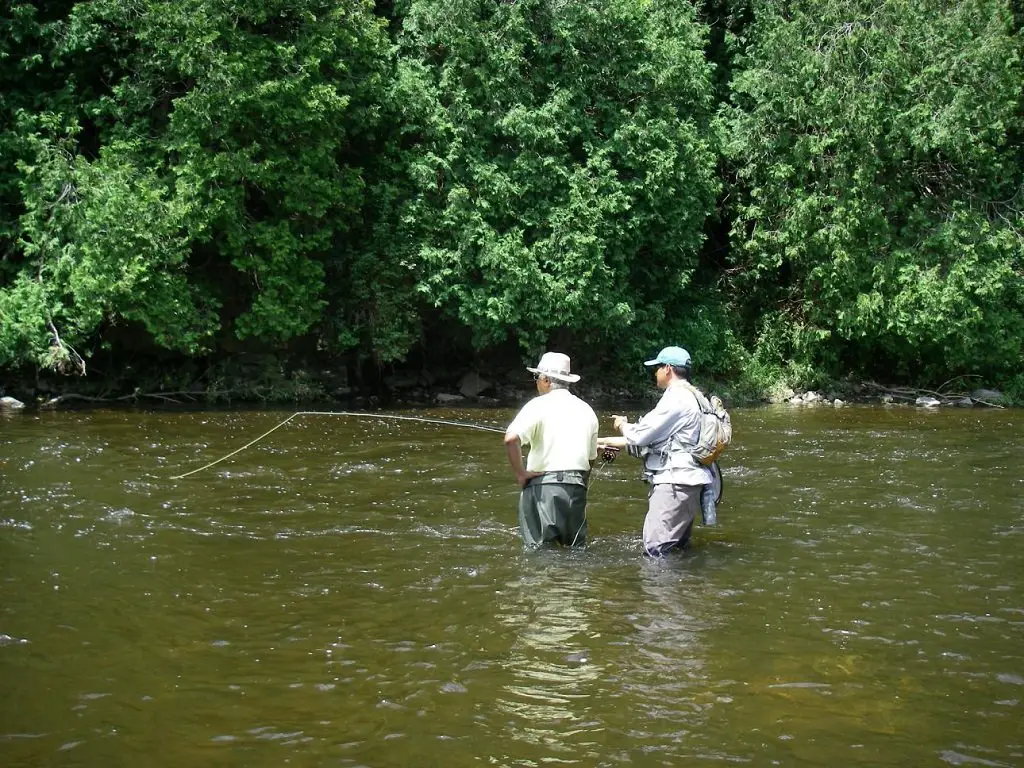
If you want to learn to fly fish you’ve come the right place. As a guide for the last 22 years, I have taught thousands of anglers how to fly fish for trout, steelhead, salmon, and bass. I have come up with some simple steps that will make it easier for any angler to learn to fly fish.
To fly fish well you need the following:
- The right gear
- The right fly for the species you want to fish for
- Three good knots
- A river or lake to fish
- Knowledge of where to find the fish and how to fly fish
- Casting practice
For some anglers learning to fly fish, it can be confusing or frustrating, but it doesn’t need to be if you follow the same ten steps and the same advice I give to all new fly clients.
We may make a small commission from some of the links on this website, which is at no cost to you. I appreciate your support.
1. What Type Of Fly Fishing Should I Start With?
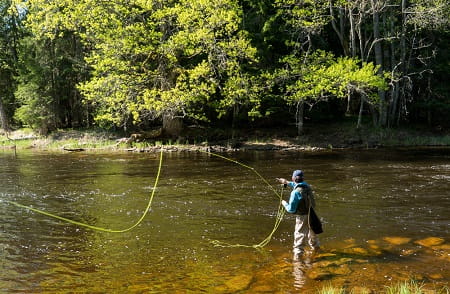
There are five main fly fishing methods, but don’t worry because you don’t need to learn how to do them all.
I recommend that you determine which one or two fly fishing methods interest you the most and then focus on learning just them.
Don’t try to learn how to dry fly fish, nymph fish, streamer fish, wet fly fish, and Spey fish all at once, or you will end up doing each one poorly and none of them well. Just learn one at a time.
2. What Species Should I Fly Fish For?
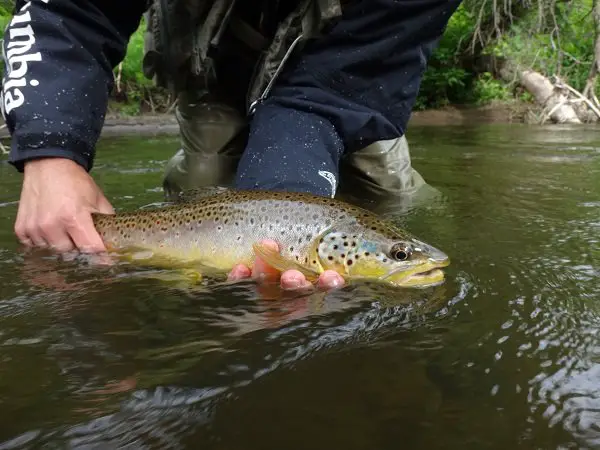
If you are going to learn how to fly fish you should also have an idea of what species you will be fishing for. This will help you determine what the next steps are.
Knowing what species you would like to target can also help you determine what fly fishing methods are best
There’s not much point in learning how to dry fly fish if your target fish is a steelhead or salmon since they don’t come up for a fly often. Even if steelhead can be caught on a dry fly, which they can, it’s a very different method than you would use compared to dry fly fishing for trout, or bass, or pike.
However, fly fishing steelhead and salmon are well worth doing, and as a guide, I do a lot of it.
When my clients want to learn how to fly fish for trout, salmon, or steelhead, I usually teach them to nymph first. With nymphing you don’t even know how to cast.
If it’s fly fishing for trout, I nymph first and then move to dry fly fishing after so that they can catch trout both below and on the surface.
I rarely teach new clients more than two methods at a time otherwise they just get confused and frustrated.
If a client wants to learn how to fly fish for steelhead I teach them how to nymph first, then I’ll teach them how to streamer fish or how to swing flies since those are all the most productive methods.
If clients what to learn to fly fish for bass or pike, then I teach them how to streamer fish with modified casts because that’s the most effective method for thos species.
Once you know what species you want to target and what the best fly fishing method to catch those fish is, then you can buy the appropriate fly fishing gear.
3. What Gear Do I Need To Start Fly Fishing?
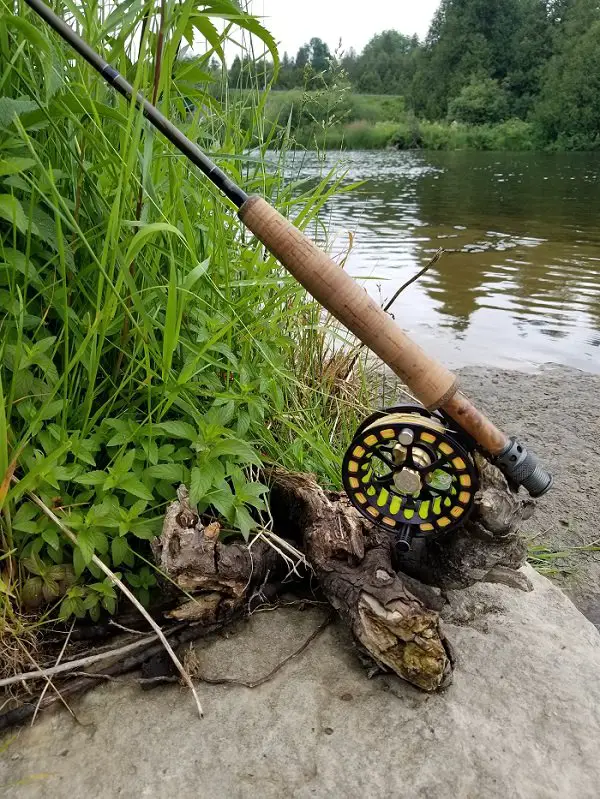
If you are going to learn fly fishing you will need the appropriate fly gear for the type of fish and the type of fishing that you want to do. Click the link and I’ll show you everything you need.
I don’t know how many times a client has shown up at the river with a rod that is way too heavy or way too light for the fish they wanted to target.
Or maybe they have a net that is too small or too big for the type of fish they want to catch, or they bought a whole bunch of nice flies that were unsuitable for the fish or the type of fly fishing they wanted to do. It happens!
Once you know the style of fly fishing that you want to do and the species that you want to fish for, you can go out and buy a suitable rod and reel with the appropriate line and all the terminal tackle.
The must-have fly gear that you need to start fly fishing:
- Fly Rod
- Fly Reel
- Fly Line
- Leaders
- Tippets
- Nippers
- Fly Box
- Flies
- Forceps
Non-essential gear that I recommend
- Fly line cleaner
- Polarized glasses
- Dry fly dressing
- Wading net
- Waders
- A vest or tackle bag
- Wading jacket
- Weights
- Indicators
Click the link for my advice on all general river fishing gear like the best waders, jackets, vests, etc.
4. Learn To Fly Cast
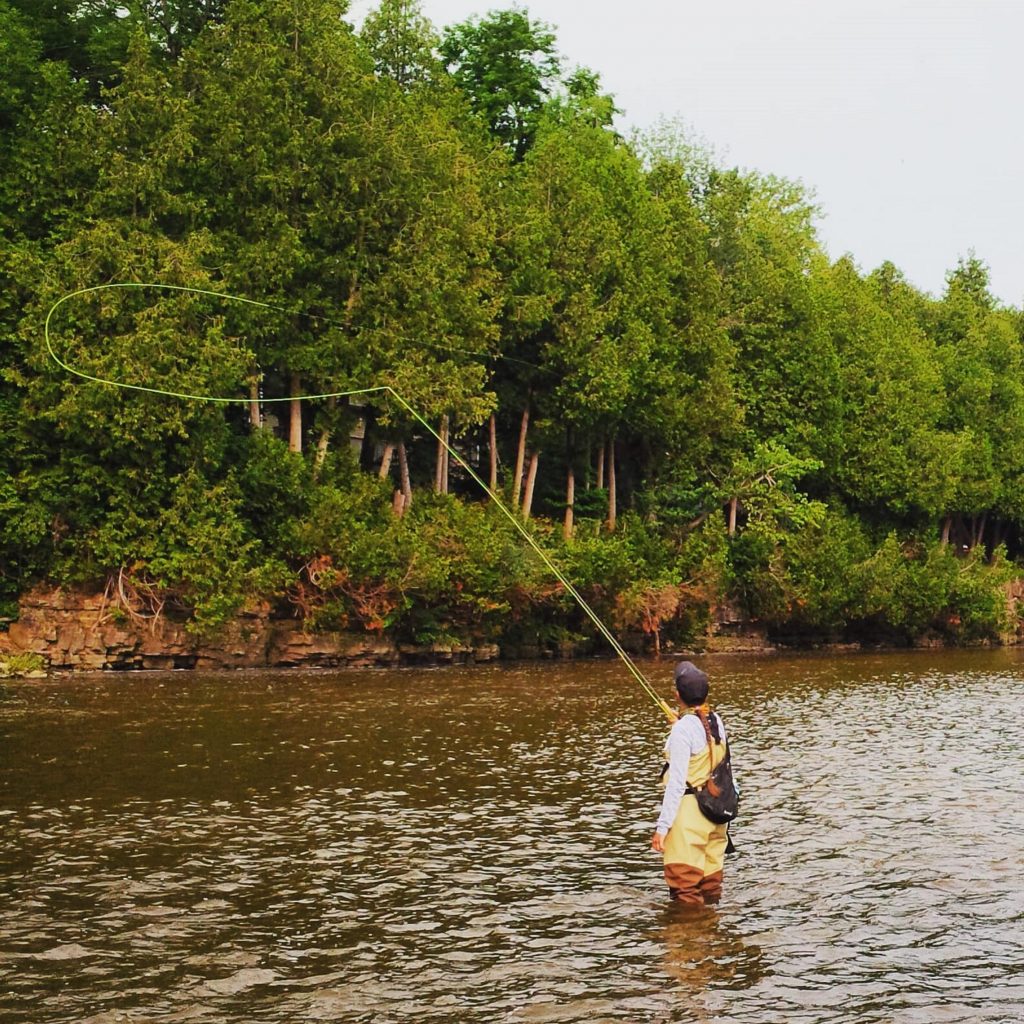
You will need to learn how to cast a fly line and the few different casts for each method that you want to fish.
If you nymph fish there is a different cast that you will need to learn than you would for dry fly fishing.
If your plan is to learn to do nymphing first then save the dry fly casting practice for later.
But if you plan to dry fly fish then you need to learn the standard fly cast and maybe the roll cast.
When I teach anglers to fly fish I start with nymphing because the nymphing cast is more like a flip of the indicator or the fly and is easy compared to a dry fly cast.
Once my clients have got a good feel for the rod in their hand while nymphing and they get a few fish in the net, then I can start working on the dry fly cast which is usually easier once you have become used to the feel of the rod.
I highly recommend taking a lesson from a guide or fly casting instructor so you learn how to do it right from the start.
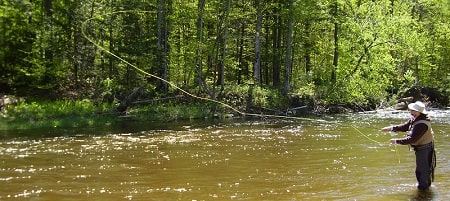
Instead of casting horribly and struggling to catch fish for years, not to mention all the flies you may end up losing in trees and all the tangles and frustrations you may have because of poor casting skills, having someone to teach you can make a huge difference.
With good casting, you can avoid many of the problems that frustrate most beginner fly anglers and you will catch fish faster and you will catch more fish.
Check out this short video for learning to cast but remember, a good video is never as good as a lesson from a good fly fishing instructor.
5. Learn The three best knots
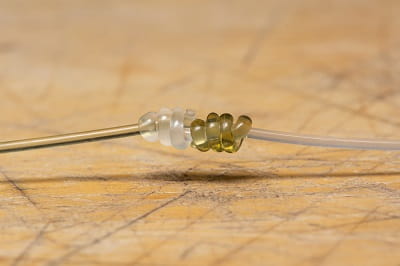
When learning to fly fish there are a ton of knots that people will tell you to use but in reality, all you need is one good knot to tie your fly onto the tippet (tippet is the bottom section of the leader) and two good knots to tie your tippet onto your leader. That’s it!
Knots are important, especially if you are fishing for big strong fish.
For all my tippet-to-fly knots I use a knot called a Double Davy knot which was taught to me by a guy who was the head coach of the USA fly fishing team who told me that most of the members of the team used this knot.
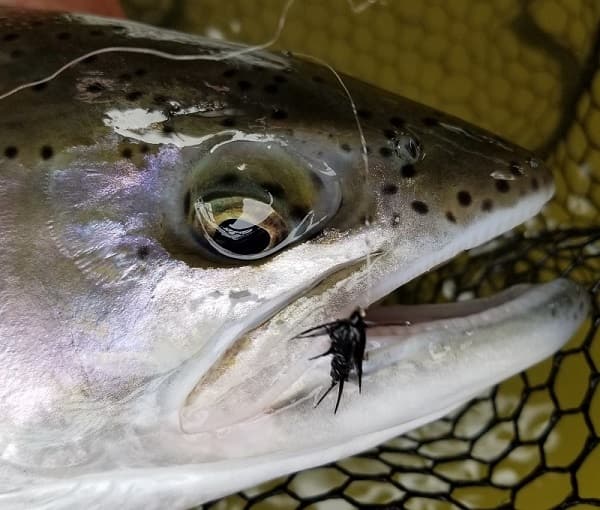
Prior to that, I used a great knot and a more popular knot known as the Improved Clinch Knot.
Both are good knots but the Double Davy is easier for us older visually challenged guys who wear glasses, and it’s also a smaller profile knot which is why I use it now.
The Single Davy Knot or just the Davy Knot is great on super tiny flies because it’s a very small profile knot but it’s not as strong as other knots so I do not recommend it when fishing for big trout and steelhead.
For tying my bare tippet to my leader I use a Triple Surgeons knot because it is easy and strong and this is the knot that I teach to my clients and my students in my classes. The triple surgeon knot is only good with a piece of line that does not have a fly tied or weight or anything on it already.
Should I need to cut my tippet or leader in the middle somewhere to add a section or to cut out a wind knot, a kink, or an abrasion, or if I already have a fly or spit shots on the tippet end of the leader, I will use a Uni to Uni knot, also known as the double uni knot.
Some anglers will also prefer a blood knot for line-to-line connections.
A Blood Knot is a good knot if you have two closely equal diameters of line that you are attaching together, otherwise don’t use it.
Tying a 4lb line to a 6lb line works, but tying a 4lb leader to a 10lb leader may give you a weaker knot which is why I recommend learning the Uni-to-Uni knot which is strong regardless of the line diameter differences.
See my article: Fly Fishing Knots For Beginners: The Ones That Guide Use.
6. Fish The Right River For A Beginner
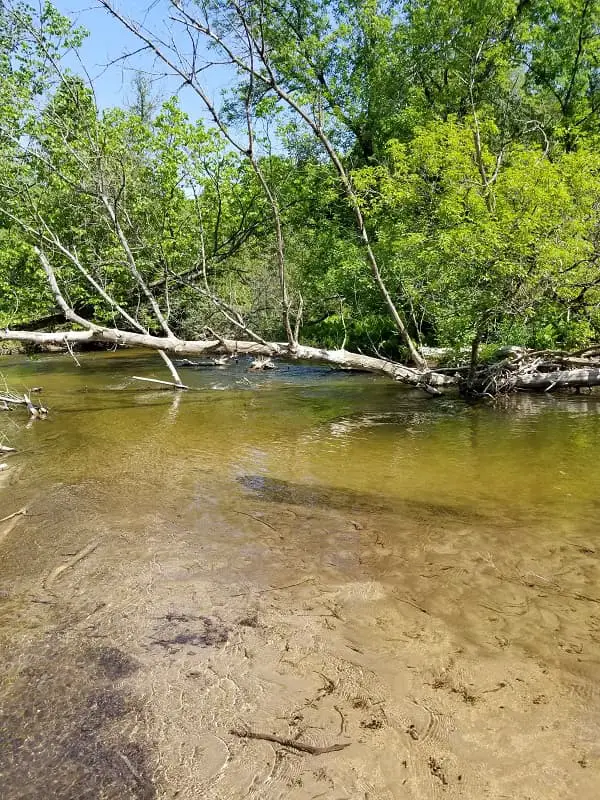
If you are new to fly fishing don’t go and fish the most technical river around or a river that is known for big fish.
Big fish don’t come easy for guys that don’t know what they are doing.
If you decide to go fish some tiny little creek with lots of trees all around you and lots of wood in the river you will likely have tons of problems and be very frustrated.
You will end up losing half your flies in the trees and the other half on logs in the river and probably not catch any fish.
If you go fish in a big river where the fish are spread out or are big and cautious you may end up catching no fish at all and it will leave you wondering if you are even doing it right.
That’s why I recommend finding an easy river to fish that has lots of little fish to catch which will give you the confidence in your skills to start fishing harder rivers with bigger fish.
7. Know A Little About Flies
Honestly, as a beginner to fly fishing, it’s best to dumb it down a little and start learning about insects of the river slowly over time.
There are also thousands of flies in the fly shop to choose from. Read this before you buy a single fly!
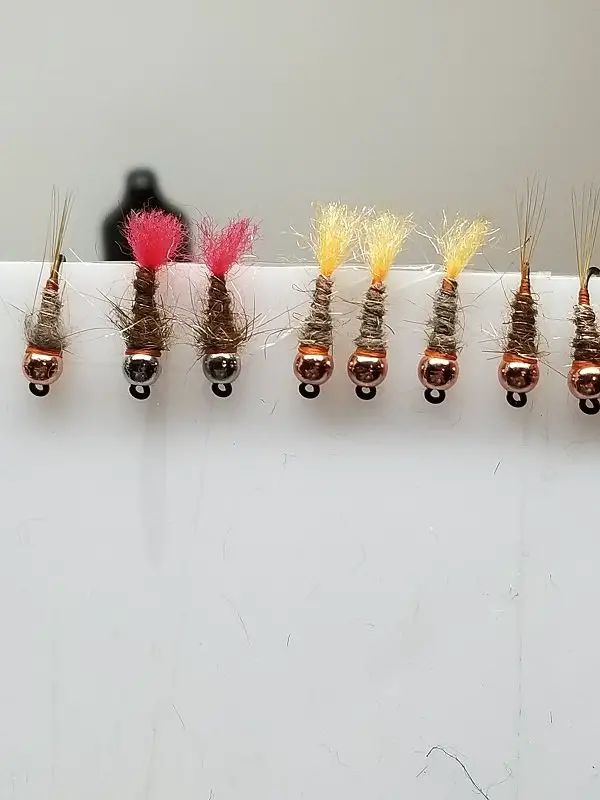
A simple fact of the matter is that when it comes to fly selection trout are less picky than most guys think (most of the time).
Why else do anglers all over North America catch a lot of trout and steelhead on attractor flies?
Attractor flies are flies like these yellow and red-tailed flies in the picture and they don’t look like real insects.
Attractor flies like the famous Rainbow Warrior Fly have caught lots of small and large trout for me and my clients on days when imitation flies that look like the real bugs don’t work very well.
When learning to fly fish, I think it’s better to focus on learning some of the other more important things like learning where the fish are, learning to present your fly properly, and learning to approach the fish better.
Having the best fly on for that day is useless if you don’t know how to fish it well, or you spook the fish before you even make your first cast. It’s important to be stealthy and approach from the right angle.
I think presentation is far more important than the fly but there are lots of factors that are just as important as the fly!
Most rivers have hatch charts that you can use as a guideline to help you choose the flies for your area but I have many trout flies that work great everywhere I go, so click the link to see my best 29 flies or my favorite spring flies.
There are also certain flies that are very effective if you plan to fly fish for steelhead or nymph for salmon, click the links for more.
Tying your own flies saves you money and lets you tie custom flies that will probably work better. If you already tie your own flies requires the right Fly Tying Hooks, and if you want to start tying your own flies you will need a good fly tying Kit.
Pro-Tip: Dry flies start to sink so I use what is called a Fly Floatant, you just need to know how to use them effectively, so click the link for the best fly floatants and my tips on how to use them better.
8. Learn To Read The Water To Find Fish Easy
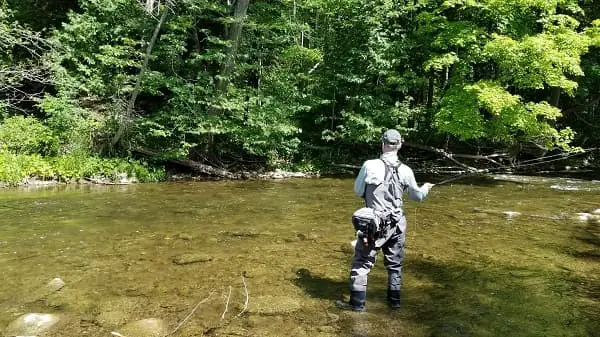
To learn to fly fish well you need to learn where the fish are or we call it learning to read the water.
Reading the water simply means knowing where the fish should be and where they shouldn’t be.
Most of the time I say 80% of the water can be ignored because the fish are usually only in 20% of the river. Knowing how to read the water will help you find that 20% of the river.
Trout in steelhead in rivers tend to use the same water so if you can read the water on one river then you should be able to read the water on other rivers. If there are rocks, logs, or other structures in the river you can bet that the fish will use it as cover. But not every rock or every log is equal.
Trout and steelhead and even salmon in a river like the deeper sections with some current. The current brings them food and oxygen and offers them some security.
If you find some deeper water with some big rocks or a log you have likely found a great spot.
When I say deeper water, I don’t mean it has to be 6 to 12 feet deep.
As seen in the picture above and below, deeper water can simply be a matter of all the water around you is 12 inches deep, and then one spot is 24 inches deep. The fish will find these slightly deeper spots and hold there.
Know The Best Way To Approach The Fish
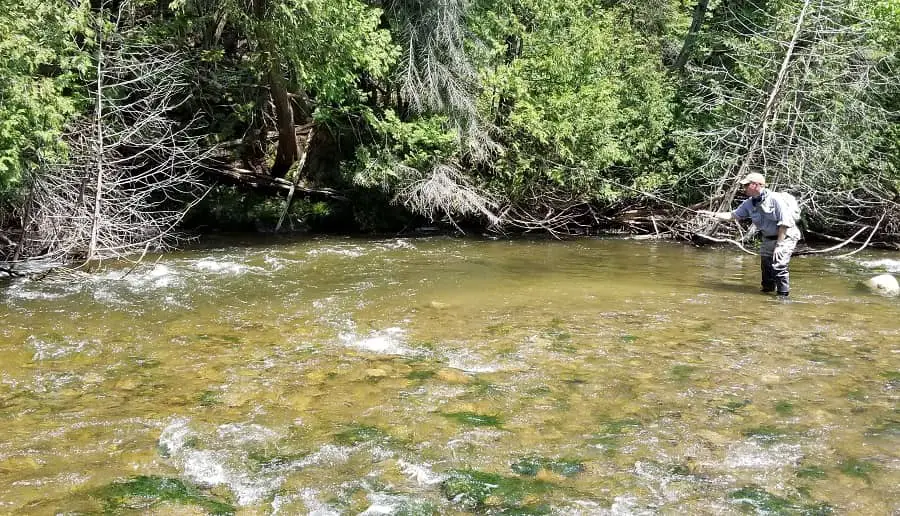
When you fly fish, you need to know how to approach the fish.
Spooking fishing is a huge problem that new anglers make and it can be easily avoided.
I tell guys that I can teach them how to cast, teach them how to present their fly like a pro, and even put the best fly on their line, but none of that will matter if they rush into the next spot so loud that every fish from 300 feet knows you are there.
And if you approach the fish from upriver you are probably not going to catch many big fish because fish are almost always facing up the river so they will see you coming and they will go lock-jaw.
It’s kind of like trying to sneak up on a feeding deer head-on, the chances are good that the deer is going to see you coming and will stop feeding, and that’s exactly what big trout do when they see or hear an angler coming, they just stop feeding.
I have taught anglers how to present their fly properly, stay stealthy and fish from behind, and once I teach them this, they go from catching 6 to 12 trout a day to catching 30 or 40 in a day, and the size of the trout goes up too.
If you want to catch more and bigger fish one of the most important things you need to do is learn to approach the fish slow, stay super quiet, and come in from behind them.
Match The Speed Of The Current
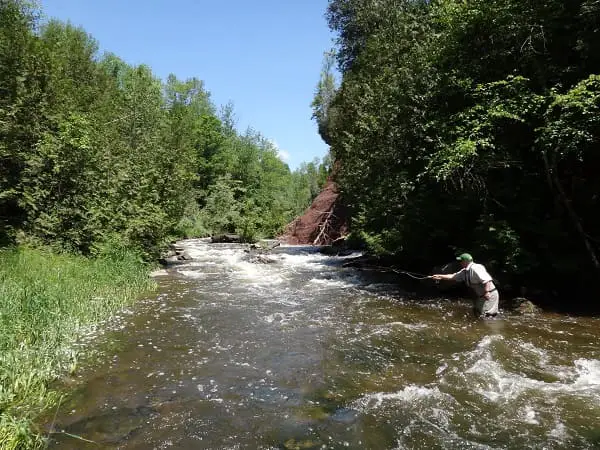
You need to understand that the way you present your fly will be one of the most important things you will need to know how to do well.
Not presenting your fly well will mean few big fish, even if you do all the other things right or even if you have the best fly on your line.
It’s the reason anglers go for years catching a bunch of little fish and rarely catch big ones.
I find that because they are catching little fish all the time they think they are doing it right and that soon they will get lucky and get a big one, but that’s not often the case.
If you only catch little ones you are probably doing something that the big ones don’t like.
I tell anglers I could rip a small piece off my coffee cup put it on my hook and catch little fish all day. Little fish are dumber than dumb so they will fall for your poorly presented fly.
Big fish will see that poorly presented fly and ignore it, and worse, a poorly presented fly may even spook them and stop them from eating altogether so you need to make sure the first drift and all other drifts after that have a good presentation that won’t spook those big fish.
The best thing I can tell you is that you need to match the speed of the current where their food is and not to bounce your fly or drag your fly around during the drift. This is a tricky one because even anglers with many years of fly fishing experience still don’t do this well.
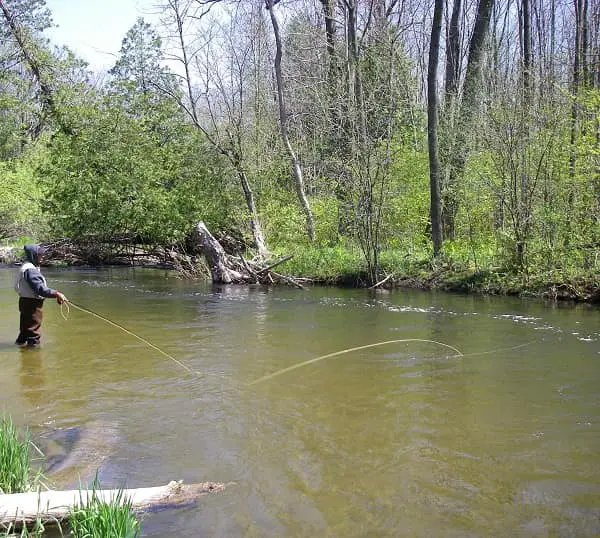
If your fly is on the surface you need to make sure it’s not dragging too.
Dragging occurs when the current pulls the fly line or the leader too fast which then pulls your fly unnaturally fast.
Unnaturally fast looks unusual to big fish and they will ignore your fly then and maybe on all future drifts too.
You need to match the speed of the bubbles or the real insects on the surface.
Drag can occur without you even noticing when your fly is deep underwater. Often the current near the river bottom is slower than the surface current.
Slowing your fly down using mends or holding your line back to match the bottom current can make a huge difference in catching more fish.
A mend, or mending the line means repositioning the line to get a better more natural drift.
Most mends are done upriver of the fly to prevent the line from passing the fly and then dragging the fly too fast. Watch this video on how to mend a fly line.
If you mend properly, you can match the bottom speed better and that means it will look more natural to bigger fish and your chances of catching them go WAY up.
Know How To Land A Fish
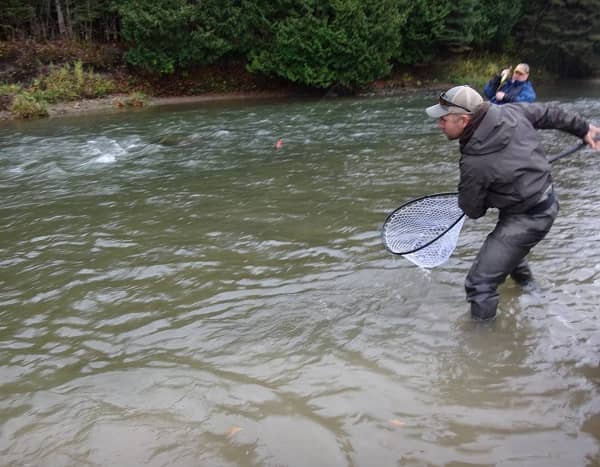
Most fly rods are around 9 feet long and I have watched too many anglers reel in their fish all the way to the tip of their rod thinking that is what they needed to do.
Unfortunately, the tip is 9 feet away from you and so then is your fish, this is a rookie mistake.
I tell all my clients to never reel in more than a rod’s length of the line.
If my rod is 9 feet long I leave 10 or 11 feet of line out which is perfect for dragging that fish into my net. Changing your rod angle in the right direction will bring that fish right into the net for you.
I can’t stress enough using a net to help you land and manage all your fish. “AIR KILLS FISH” so dragging a fish up on the bank, fumbling to get the hooks out, finding your camera, and then trying to release the fish will likely kill that fish shortly after you release it.
If you plan on releasing your fish you should know that even dragging the fish up onto the rocky bank can kill the fish. They flip and flop and smash their heads off the rocks which studies show often kills them even if you watch them swim away looking healthy. USE A NET!
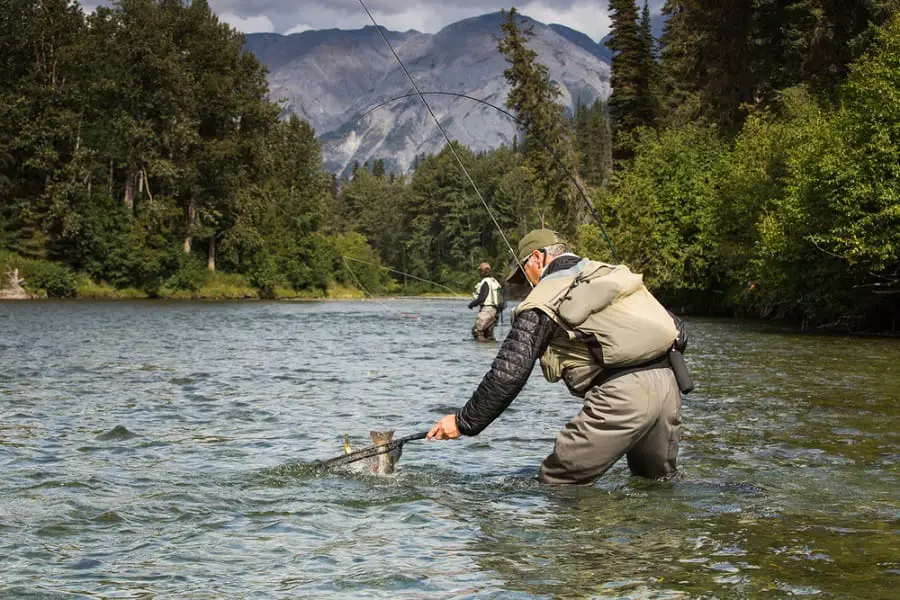
Not only that, but I have seen and heard the stories about guys getting that fish of a lifetime on and then losing it at their feet and hearing them say, if I only had a net with me I would have landed that fish.
My net cost about $25 dollars and some years I’ll put 500 fish in that net. There is no excuse for not having a net.
I use and recommend many nets but I use an inexpensive but good trout net like the Frabill Trout Net which is suitable for wading along the river. At that link, I will also show you how to rig the net properly so it’s easier to grab when fighting a fish and so you don’t lose it.
I use the 13″ x 18″ for trout and the 19″ x 23″ for steelhead.
Guide Tip: My net hangs off my back and is out of my way when I don’t need it but it’s always there when I want it.
Know The Fishing Laws For Your Area
Don’t get caught fishing out of season or in areas where no barbs or bait are allowed, or where there is catch-and-release only rules.
It’s your responsibility to know the rules for the area and the river you plan to fish on so look it up before you go.
Talk To A Local Fishing Store
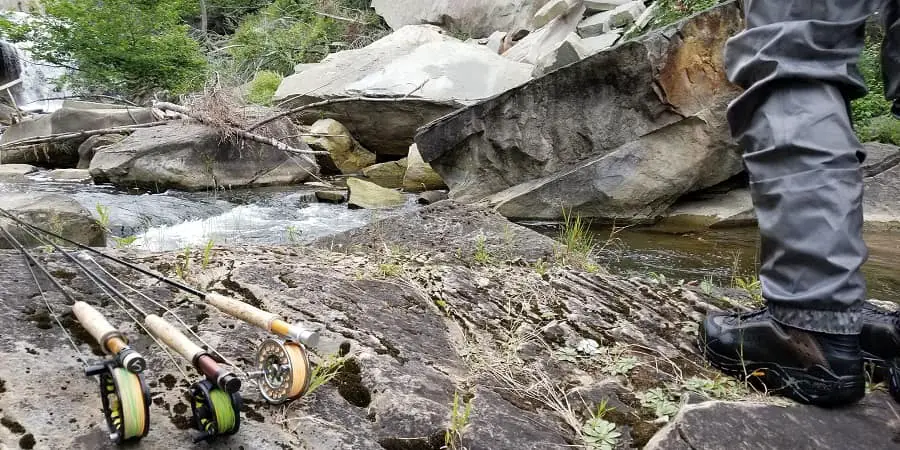
The local fly shops can be a wealth of information, from the current river conditions to the best flies to use, the best time, the best guides in the area, and the best methods to use.
The guys in the fly shops fish the local rivers and are often very helpful, so go buy something and pick their brains while you are there.
Guide Tip: Yes, there are sometimes good fly anglers in the Big Box Stores, but not always. Most of the time the big-box sales staff are “jack-of-all-trades” and know barely more than you will. Smaller local shops are always best!
Learn To Fly Fish Faster With A Mentor
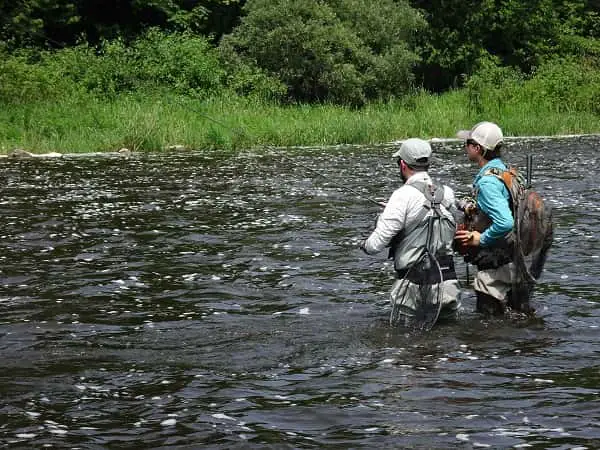
I have guided anglers that have been learning on their own for 10+ years, and 1 day with me and they go from catching a few fish each time out to having a ton of confidence and then catching 5 times as many fish as they ever have before.
The problem is that, when you learn to fly fish on your own, you might end up learning the wrong methods for your rivers and you may end up practicing it for many years without even knowing that it’s not the best way to catch fish.
Once I show anglers the better ways to catch fish on the local rivers they instantly start catching more fish. That’s why if you want to learn to fly fish, a local fly fishing guide or mentor is invaluable.
If you can’t afford a guide find a mentor. Not the guy that’s been fishing wrong for 10 years, but a guy that regularly catches fish and actually knows what he is talking about.
Another way to learn fly fishing is through a local club. You may find local fly clubs where you can meet guys to learn from, or you may find a fishing partner on local Facebook clubs.
Local clubs share information and they may even have top guides come in a teach the guys the right methods, some secret flies, and new local hot spots.
Whatever way you want to do it, learning from someone else will greatly reduce the learning curve and will get you into a lot more fish faster.
Guide Tip: Be observant, I watch new anglers walk past me or other good anglers all the time. What they should do is stop, watch, and learn especially if the guy fishing is a good angler and is catching fish.
If you see someone catching a ton of fish and you’re not, stop fishing for a while and just watch what they are doing. Try and determine what is that guy using as a fly, what method is he using to fish that fly, and where is he catching all the fish. Why is he catching but you aren’t?
Guide Tip: If someone is catching lots of fish, it’s less likely his fly that is the difference, and more likely his presentation.
Stream Etiquette
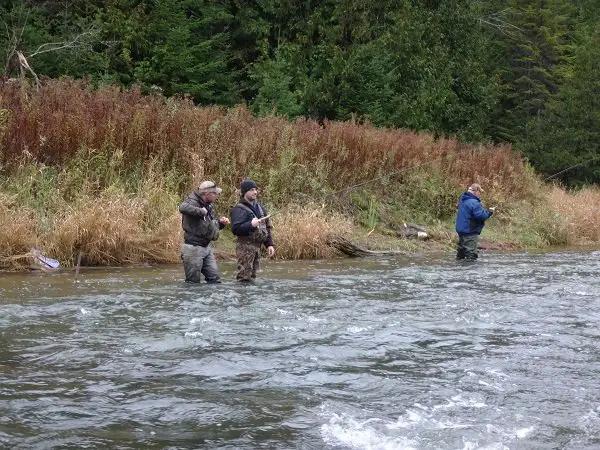
If you are going to learn how to fly fish you need to learn how to fish around other anglers and conduct yourself properly so you and everyone around you can enjoy their day.
You should offer respect for others around you, and don’t be the idiot that stomps in too close to another angler and spooks all the fish in the pool.
These are my tips for fishing around other anglers.
#1. Leave the other guy alone – If there’s another pool close by, go fish it instead of crowding out another angler. That angler may be slowly and quietly working a big trout and you walking in might spook it and piss the guy off.
#2. Move In Quietly – If all the spots on the river have anglers in them and you are forced to go fish with another angler, do so, but move in so quietly that not a single fish will hear you and give the guy as much space as possible, and never cast at the same fish he is fishing for.
Also, try to find the biggest pools, and don’t try to squeeze into a 10 foot x 10 foot spot.
Guide Tip – Once you really understand trout in rivers you will start to realize that not all the fish are in pools. There are days on some busy rivers where I will land 30 fish and not set foot in a single pool. I will fish 3-foot by 3-foot pockets, riffles, and runs and catch a ton of fish. Try this before you crowd someone out in a pool.
#3. Stay As Far Away As Possible – If you are heading up the river to another spot and you see an angler don’t go stomping through the river right behind him spooking all his fish. Instead, try to walk as far around him and as quietly as possible.
#4. Don’t litter! – I don’t know how many spots are now closed off to fishing because a bunch of A-holes couldn’t be bothered to bring out their empty beer cans or empty coffee cups.
I know a lot of landowners along the rivers and they don’t hate anglers, they hate the garbage and they simply get frustrated to the point where they post their properties and refuse to let anglers into fish.
Lots To Learn About Fly Fishing
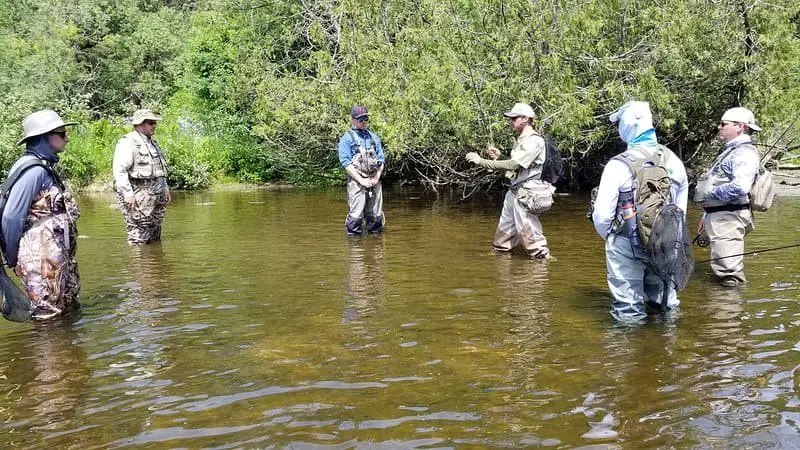
I get asked many questions on the river by my clients so I made a page answering 27 questions beginner fly anglers often ask.
Questions like is fly fishing more productive, or what tippet or leader should I use?
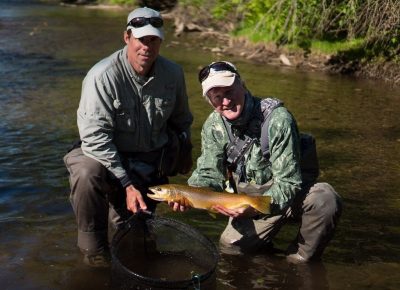
Our guides and I are here to help.
If you have a question that I didn’t cover in this learn to fly fish article, or you have some advice, just let us know in the comments section below.
Tight Lines
Graham
I discuss the most common question I get at What is Fly Fishing and 26 Other Common Fly Fishing Questions Answered
